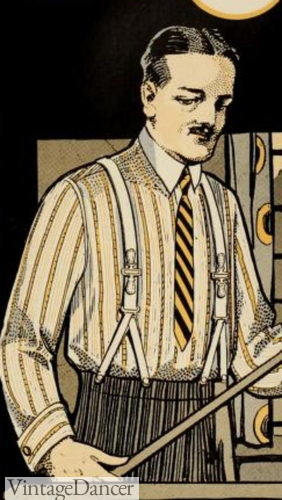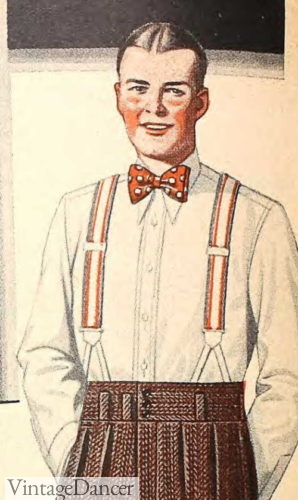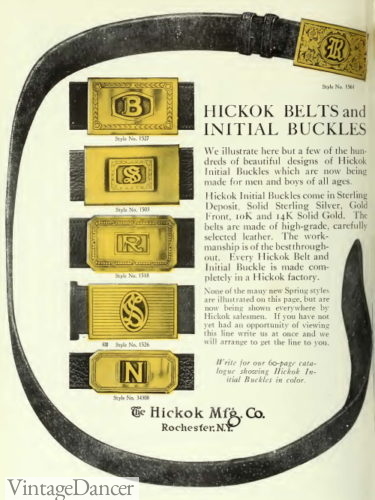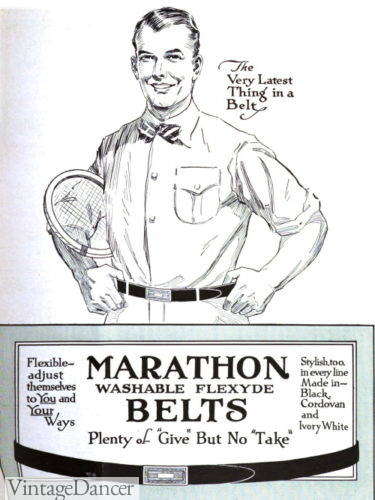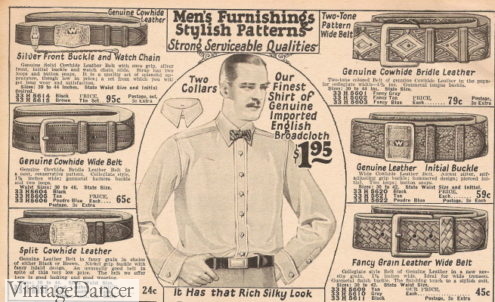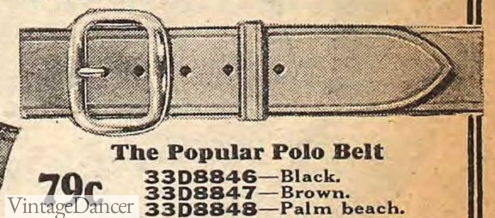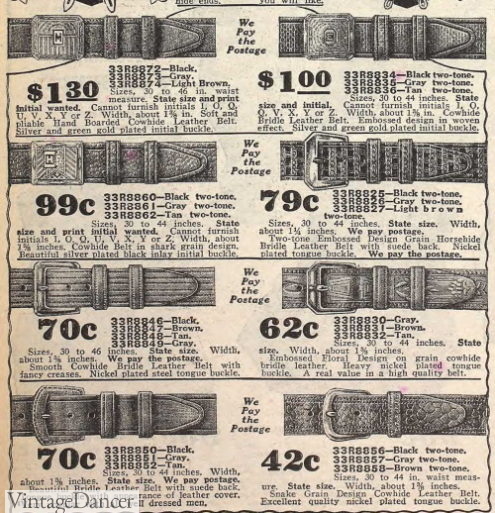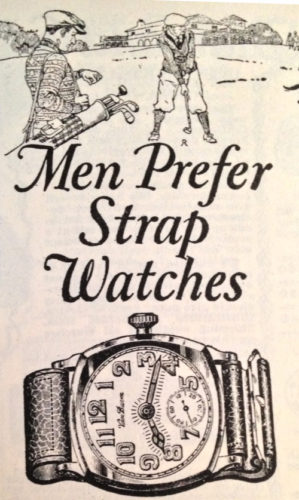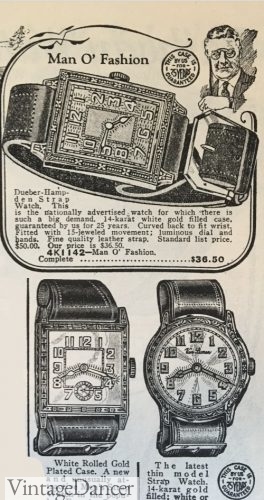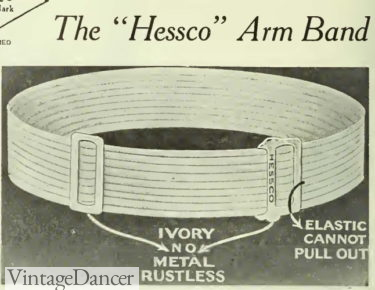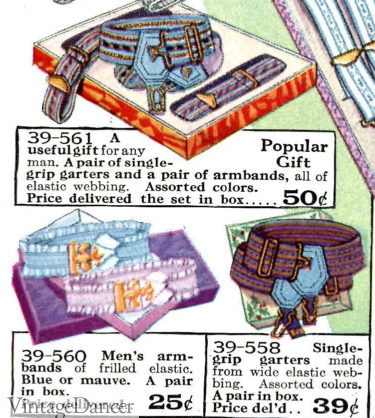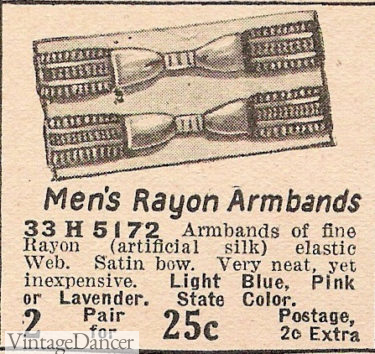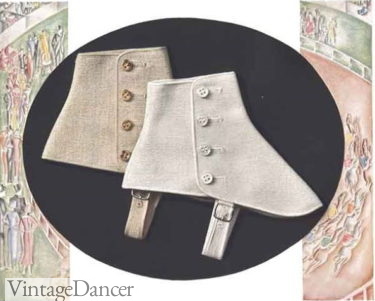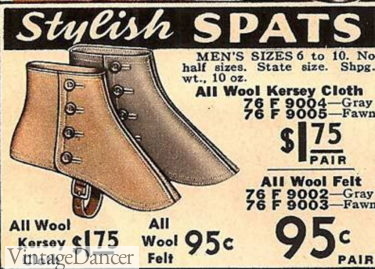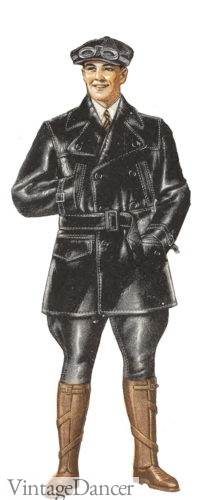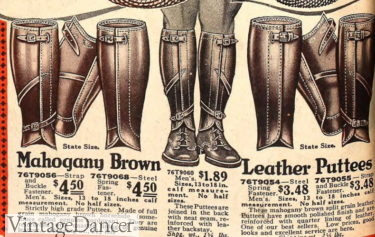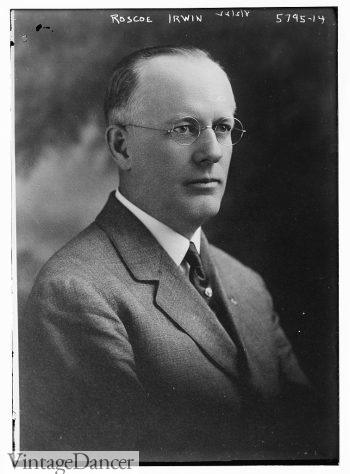This article briefly looks at trends in these men’s 1920s accessories:
- Suspenders and Belts
- Gloves
- Watches
- Handkerchief
- Sleeve Garters
- Spats
- Eye Glasses
- Umbrella and Cane
- more accessories
Suspenders
To keep high waisted pants up, men used button-on suspenders (clip-on were not invented yet.) They were made of silk, rayon, elastic webbing or leather. The traditional white suspender was worn by mature men while the younger me preferred stripes, jacquard, polka dots, plaid and geometrics. Shop suspenders.
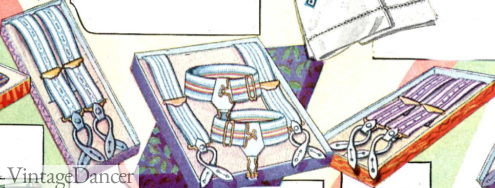
1937 suspenders, pastel stripes
- 1921 white suspenders
- 1929 striped suspenders
Suspenders were seen as underwear and should never be publicly seen. For summer outfits and casual sportswear, when it was too hot to wear a vest, men would wear a belt instead of suspenders.
- 1920 black leather, brass buckles
- 1920 plain leather, silver buckles
Leather belts were black, brown, tan or grey leather. Smooth leathers or light textures were common in the early years. Rough textured leather, reptile skins were trendy in the late 1920s.
Belts buckles were mostly plat style in silver or brass with initials, western details, or plain. The buckle belt style was seen in the mid 1920s, sometimes called the polo belt. Buckles shapes could be round and simple or geometric pentagons and hexagons.
belts widths changed a lot in the 1920s. In the 1920 the average width of 7/8 inch up to inch, very narrow! The mid to late 1920s had a standard 1 3/8 inches width. The late 20s had a brief trend for double buckle extra wide belts.
- 1927 belts
- 1925 polo belt
- 1929 textured belts
At no time should a belt and suspenders be worn together. The only time a man may have done that is if his pants were too small and he could afford to buy new ones.
Gloves
Learn about men’s 1920s gloves.
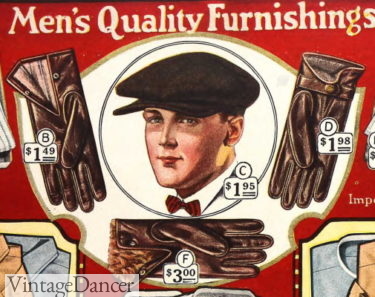
1925 lined driving gloves
Watches
Wristwatches grew in popularity throughout the ’20s. In the beginning of the decade, wristwatches were basically pocket watches on straps. Over time, watchmakers used smaller works specifically made for watches, which allowed for a change in shape of the watch. Rectangular watches with rounded corners became available.
- 1927 strap watch
- 1927 Man of Fashion men’s watch
Many men still carried fob watches, AKA pocket watches. They dangled from a watch chain, which attached to the vest on one end and the watch on the other. The watch sat in another pocket on the opposite side of the vest.
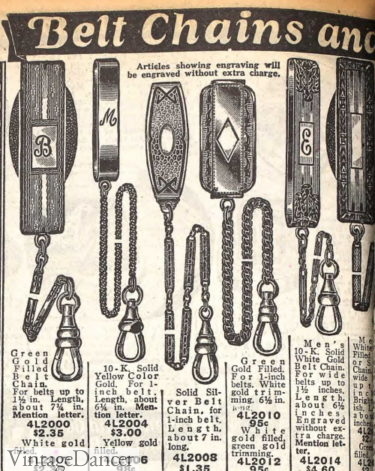
1928 belt clips
But what about a man who wasn’t wearing a vest? A belt clip with chain was the solution. Belt clips were usually yellow gold with a monogram in the center to match the monogram on the back of the pocket watch. For traditional men and extra stylish gangsters, a wrist watch was still too sporty and casual. The pocket watch was a slow fad to die.
Read more about the history of men’s watches.
Handkerchiefs
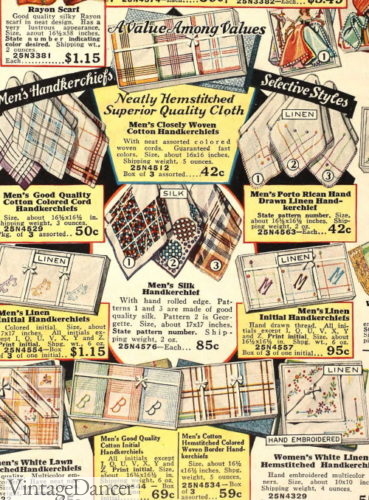
1928 mens handkerchiefs
There are two reason for men to carry a handkerchief. The first is for decoration as a pocket square in the suit coat. The pocket square was of a hue that coordinated with the necktie. It was a relatively new trend in the 1920s to wear a colorful pocket square with a suit.
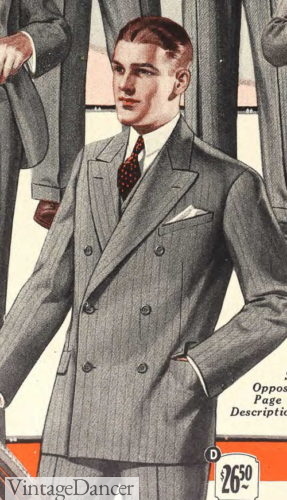
1926 suit with pocket square
The second type was a plain white cotton or linen handkerchief that was for practical purposes, not decoration. Wiping sweat off a hat band, dabbing food off a chin, or clearing a nose, the white handkerchief was frequently in use. It was kept in the pants or an inside coat pocket at all times. The handkerchief was often monogrammed with the owner’s initials – a common handmade gift from family members.
Sleeve Garters
1920s sleeve garters, which historically were used to keep too long and baggy shirt sleeves out of the way, were a useful accessory. Shirts were sold by neck size, not sleeve length, so they were usually too long for many men’s arms. The sleeve garter, worn around the bicep, held you shirt sleeves away from wrists. Bankers, musicians, and bartenders are just some of the occupations who needed them most.
Made of elastic webbing with an adjustable slide, sleeve garters or arm bands came in pastel stripes – sky blue, purple, pink, yellow, etc. They were often sold in gift sets with suspenders and sock garters. Fancier designs had a ruffled edge or a bow tie. It was one hardly ever seen men’s accessory that could feature colors not seen in outerwear. Here are some examples.
- 1920 elastic arm bands
- 1928 pastel striped elastic or ruffle edge armbands
- 1927 rayon silk armbands with bows
Shoe Spats
Shoe spats were one item that continued into the early 1920s as strongly as before with certain fashionable gentlemen. I am referring to Gangsters, Bootleggers and other notorious thugs of the 1920s. With all that money from illegal alcohol sales making them filthy rich, they made an art of wearing the most high end fashions.
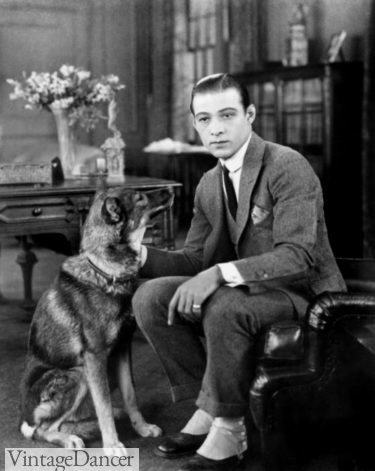
Rudolph Valentino wears white spats over his boots
Grey, tan (fawn) or off-white wool or linen spats with pearl buttons on the sides became synonymous with gangsters. However regular men wore them too. They did a nice job of keeping shoes clean and ankles warm in winter.
- Linen shoes spats
- Wool shoe spats
For evenings, white spats or patent leather back spats were another way to dress up a little bit more for that old school Victorian aesthetic. Shop here for spats.
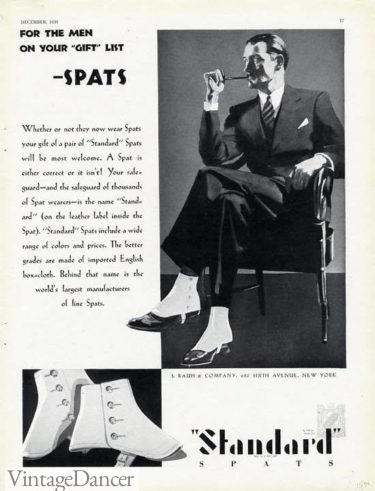
A less formal use for spats were as wool leggings or leather puttees (known now as gaiters). They served the purpose of protecting legs when short boots were worn with short pants, called breeches or plus fours. The puttees fit over the boot and calf, acting like a tall boot.
- 1929 all leathers motorcycle outfit with puttees
- 1924 puttees
Eye Glasses
Men and women wore the same eyeglasses, with most people opting for round frames, although some favored oval and octagon. Rimless or pinch nose frames were still common from early decades, although they looked dated.
Round horn or shell-rimmed frames were worn throughout the decade, but sturdier wire gold frames gradually replaced them.
- Round glasses tortoise shell
- 1922 Roscoe Irwin’s metal frame glasses
Sunglasses followed the same trends but they didn’t catch on until the late ’20s.
More history of 1920s eyewear and sunglasses.
Umbrellas and Canes
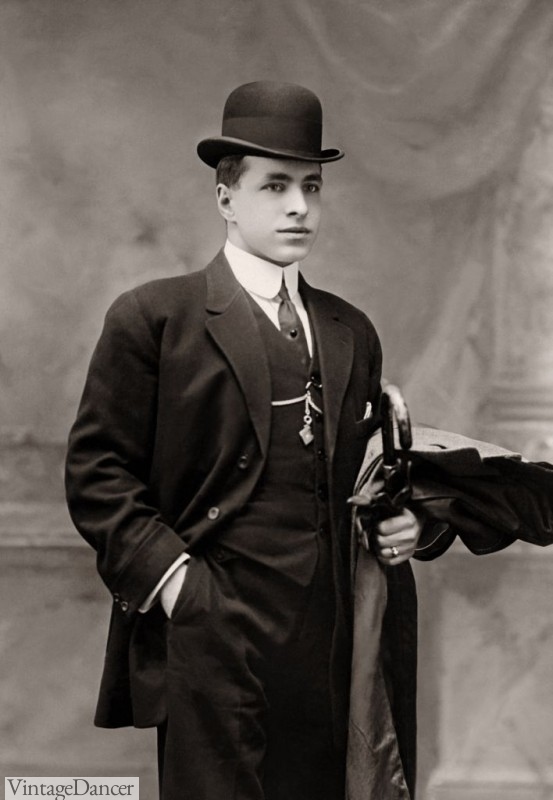
1924 Man in Classic Edwardian Style with a Rolled Umbrella
Part of men’s dress in the 1900s was to carry a rolled umbrella at all times. It was a fashion accessory, a cane, walking stick, rain covering, and occasionally a weapon. It was more popular in Britain and with American men who followed the traditional way of dressing.
Some men continued the tradition of carrying the rolled umbrellas regardless of the weather, but most men turned to canes instead. All wood umbrellas or silver top stick or handle canes were in style.
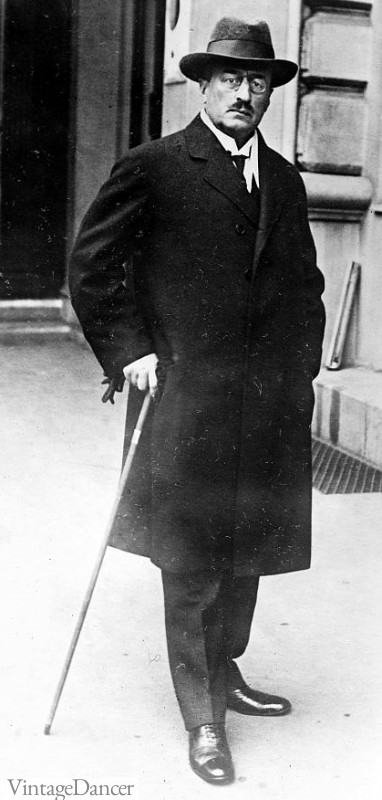
1927 Man with Cane
Women also walked with canes. They preferred walking sticks with a rope loop hooked around the wrist. Instead of these being fashion accessories for the young, they were a necessary tool for the less able bodied.
Shop more men’s accessories here.
More Accessories History
- History of 1920s Men’s Ties, Neckties, Bowties
- Vintage Men’s Socks History-1900 to 1960s
- History of Men’s Vintage Jewelry- Collar Bars, Rings, Tie Clips
- History of Men’s Watches- 1900s to 1960s
- Vintage Scarf Styles -1920s to 1980s
- 1920s Shawls, Scarves, Furs and Wraps Styles
- 1920s Headband, Headpiece & Hair Accessory Styles
Debbie Sessions has been teaching fashion history and helping people dress for vintage themed events since 2009. She has turned a hobby into VintageDancer.com with hundreds of well researched articles and hand picked links to vintage inspired clothing online. She aims to make dressing accurately (or not) an affordable option for all. Oh, and she dances too.
